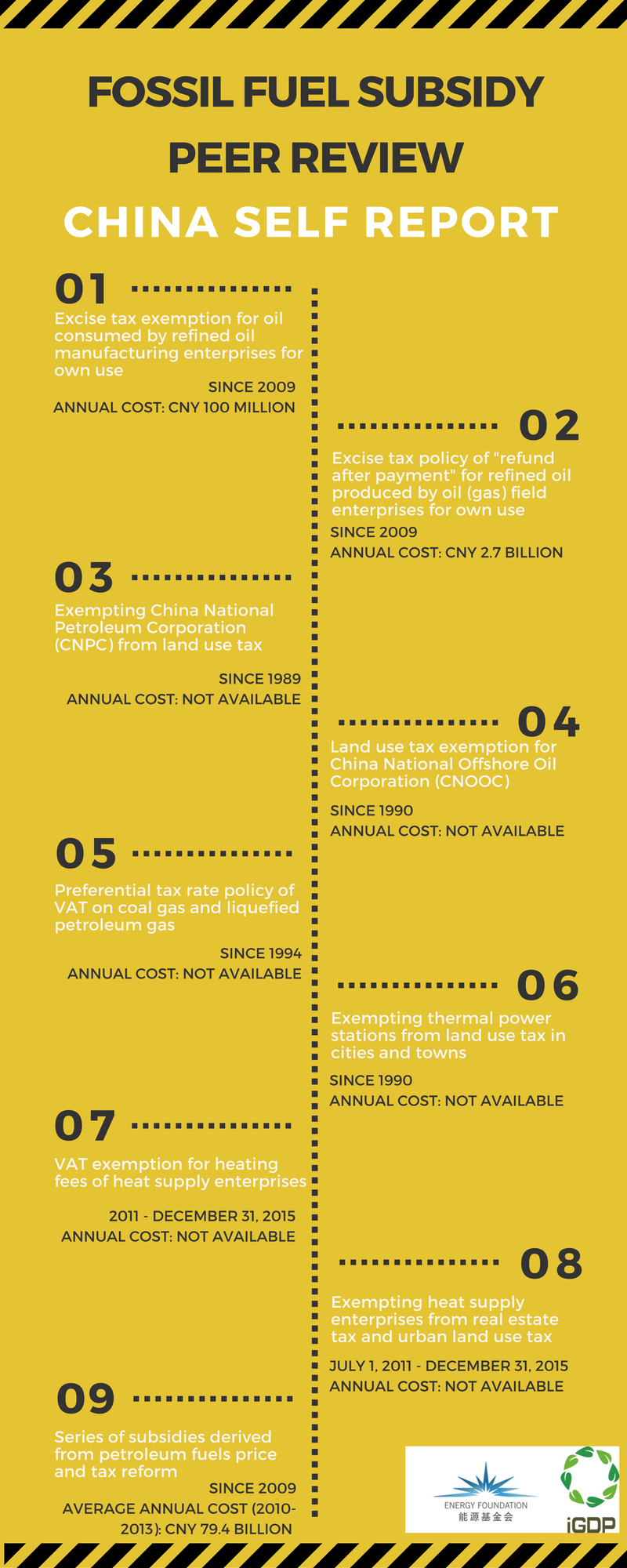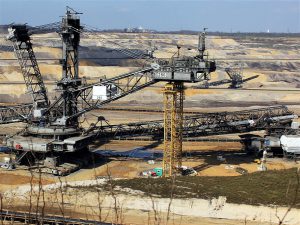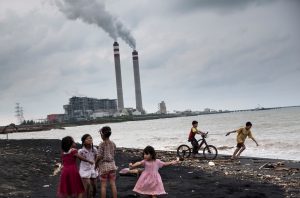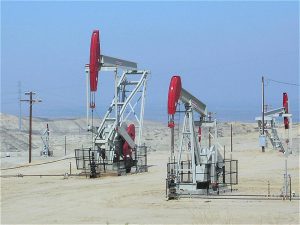The final report of the US-China fossil fuel subsidy peer review process was released in September. This process, carried out under the G20 framework, took two years to complete and produced four separate reports. The joint contribution resulted in China’s first systematic cross-departmental review of fossil fuel subsidies.
China’s Self Report provides the outside world with valuable information on domestic energy subsidies and pricing mechanisms, as well as giving China a roadmap for fossil fuel subsidy reform in the near-term.
It is the first time the Chinese government has explicitly proposed a roadmap for energy subsidy reform, complete with timetables and directions. It represents an important step forward in guiding real action.
China’s first roadmap to reform
China’s Self Report identified nine fossil fuel subsidies in need of reform, amongst them, subsidies supporting extraction and refining, for electricity and heat generation, and for end-user transportation and household consumption. The table below includes estimates of the fiscal cost of these nine subsidies, how long they have been in place, and the proposed method to reform them. A lack of data meant estimates of fiscal costs could only be provided for three policies.
| Estimated fiscal cost (100m yuan) | In effect since | Timetable for reform | Direction of reform | |
|---|---|---|---|---|
| Subsidies for the exploration, development, and extraction of fossil fuels | ||||
| A consumption-tax policy of ‘refund after payment’ for refined oil produced by oil (gas) field enterprises for own use | 27 (corrected figure) | 2009- | Near to mid-term | Move point of taxation for refined oil |
| A policy of exempting China National Petroleum Corporation (CNPC) from land-use tax | Not currently available | 1989- | Mid to long-term | Cancel policy |
| A policy of land-use tax exemption for China National Offshore Oil Corporation (CNOOC) | Not currently available | 1990- | Mid to long-term | Cancel policy |
| Subsidies for refining and processing of fossil fuels | ||||
| A policy of consumption-tax exemption for oil consumed by refined oil manufacturing enterprises for own use | 1 (corrected figure) | 2009- | Near to mid-term | Move point of taxation for refined oil |
| Subsidies for power and heat generation | ||||
| A policy of exempting thermal power stations from land-use tax in cities and towns | Not currently available | 1989- | Mid to long-term | Cancel policy |
| A policy of VAT exemption for heating fees of heat supply enterprises for individual residents | Not currently available | Heating season of 2011 to end of 2015 | Mid to long-term | Cancel policy |
| A policy of exempting heat-supply enterprises from real-estate tax and urban land-use tax | Not currently available | July 1, 2011 to end of 2015 | Mid to long-term | Cancel policy |
| Subsidies for fossil fuels used in transport | ||||
| A series of Subsidies Derived from Petroleum Fuels Price and Tax Reform | 940 | 2009- | Mid to long-term | Improvements |
| Subsidies for fossil fuels used in the residential sector | ||||
| A preferential tax-rate policy of value-added tax (VAT) on coal gas and liquefied petroleum gas | Not currently available | 1994- | Mid to long-term | Abolish 13% preferential VAT rate |
Under the roadmap, two subsidies (exemptions from consumption taxes for fuels produced and used by oil and gas firms) are to be reformed between 2015 and 2020, while reform of the remaining seven policies is expected before 2030.
A boon for local government
Of the nine policies identified in China’s Self Report, four relate to exemptions or reductions in urban land use taxes. A major part of the next phase of subsidy reform will be the removal of these preferential tax policies.
This is good news for local government. China’s 1994 fiscal reform plan devolved powers over the collection and spending of urban land taxes to local government. The preferential taxes offered to big oil and gas companies have resulted in both a loss in revenue for local government, and environmental damage.
A good example of this is Dongying, in Shandong province on China’s east coast. Oil and gas giant Sinopec’s Shengli field alone paid 5.05 billion yuan (US$740 million) less in tax in 2013. Similarly, tax authorities in Shaanxi province, north-western China, calculated PetroChina’s Changqing field is exempt from 115 million yuan (US$16.9 million) in land taxes annually.
Local governments have been strongly opposed to these tax exemptions and have long-lobbied the Ministry of Finance and other central authorities to abolish them.
Reform of this policy is already underway. In 2015, the scope of exemptions from urban land taxes for oil and gas firms was narrowed, which resulted in large increases in taxation income for some local governments. Karamay, an oil and gas city in Xinjiang, for example, saw an extra 100 million yuan (US$14.7 million) in income in the first half of 2016 alone.
But these recent changes were aimed mainly at the temporary use of land for prospecting and exploration. Preferential policies are still in place for laying pipelines and for other uses. The next stage will be to do away with these subsidies altogether, in line with local government wishes.
Fuel subsidies
According to the Self Report, subsidies related to petroleum fuel pricing and tax reform represented the largest and clearest data. Media reports say that China’s central government paid out 573.4 billion yuan (US$84.2 billion) in fuel subsidies for public transport, forestry and fishing. This is approximately 20 times the amount central government spent on energy-saving and environmental protection in 2015. The fiscal burden of these subsidies is both enormous and unsustainable.
Table 2: Annual cost of fuel subsidies (100m yuan)
| 2010 | 2011 | 2012 | 2013 | |
|---|---|---|---|---|
| Fishing | 67.69 | 207.29 | 236.63 | 259.13 |
| Forestry | 15.41 | 50.1 | 61.73 | 46.34 |
| Urban transport | 96.03 | 306.53 | 363.16 | 311.53 |
| Rural public buses | 36.46 | 128.77 | 148.17 | 114.26 |
| Taxis | 63.13 | 186.06 | 209.9 | 170.43 |
| Other spending | 13.28 | 21.9 | 22.7 | 41.14 |
Fuel subsidies were launched in 2006 to cushion the impact of oil price reforms on vulnerable groups. To prevent oil price increases raising the cost of living for these groups, fishery, forestry and urban public transport sectors were subsidised to artificially lower fuel prices.
But the Self Report finds that such subsidies are poorly targeted and do not reach low-income groups. For example, the diesel subsidy for the fishing industry flows to commercial fishing firms, rather than fishermen. Such subsidies fail to meet the G20 aim of only retaining subsidies that “provide targeted support for the poorest.”
As fuel subsidies are determined based on usage, the more fuel you use the more you benefit from the subsidy. This fails to incentivise reduced usage, worsening environmental and climate problems, which are in turn felt mostly sharply by low income or vulnerable groups.
The Self Report and the peer-review report identified fuel subsidies as being ineffective and leading to waste, and calls for them to be abolished.
Although the Self Report only provided general information on how these subsidies would be reformed (e.g. a sector-by-sector approach, gradually decoupling subsidies from fuel use, and providing alternative safeguards), what is certain is that reform of fuel subsidies is already underway and there is a clear roadmap for the future.
In 2015, the Ministry of Finance and other authorities started a reform process. The G20 peer review provides a further guarantee that China will complete and move forward with this process.
Hidden subsidies
Many Chinese researchers working in the environmental field have long held the view that environmental damage caused by the production and use of fossil fuels is not reflected in fuel costs. In fact, prices are kept artificially low, which acts as a hidden subsidy.
As early as 2004, the State Environmental Protection Agency (now the Ministry for Environmental Protection or MEP) and the National Bureau of Statistics led efforts to calculate “green GDP”, which would take account of the cost of harmful factors such as air and water pollution, and solid waste.
In 2014 the MEP’s Chinese Academy of Environmental Planning found that 204.76 yuan (US$30) of environmental externalities were incurred during the production and transportation of each tonne of coal output – equal to 28% of the coal price at the time.
China’s Self Report does not recognise negative environmental impacts as contributing to ineffective consumer subsidies, but it does say that “resource and environmental taxation reforms” aimed at increasing the costs of using fossil fuels should be a key part of the subsidy reform process.
Also in 2014, research by the Natural Resources Defense Council and Tsinghua University found externalities across the entire coal lifecycle to be even higher at 260.30 yuan (US$38.23).
The peer-review group also called for an overall improvement of the data and understanding around the environmental impacts of fossil fuel subsidies in China, both in terms of greenhouse gas emissions and other forms of pollution.

The National People’s Congress, China’s highest legislative body, has already carried out a first consideration of a draft Environmental Tax Law, and a consultation process is underway.
That legislative process is an important part of China’s reform of fossil fuel subsidies. However, the rate of taxation in the draft is much lower than necessary to reflect the external environmental costs incurred, and also less than the cost of emissions reductions by businesses.
Furthermore, the proposed low rate does not match the benefits that fossil fuel companies received in “hidden subsidies”, which will greatly reduce their incentive to reduce emissions. To achieve the resource and environmental taxation reforms of the Self Report, a much higher tax rate will be needed, and, where appropriate, a carbon tax.
The direction of fossil fuel subsidy reform described in the Self Report matches closely with that of many Chinese policies that are already under way or in discussion, which will make the process smoother. The new roadmap can be regarded as a steady first step toward the reform of fossil fuel subsidies.
But when it comes to implementation, these policies cannot stand alone because they are too intertwined with other policy reforms. These include reforms of energy pricing; environmental taxes; fiscal responsibilities of central and local government, and so on.
Meanwhile, as the world strives to hit climate targets, China’s environmental taxes should aim to go beyond the scope of this peer-review, speeding up the process of reforming coal sector subsidies and “hidden subsidies” and balancing the relationship between environmental protection and economic development.
Methodology
China’s Self Report was produced by a team of experts from research bodies, academia and the business world, led and organized by the National Development and Reform Commission’s Energy Research Institute and Ministry of Finance’s Chinese Academy of Fiscal Sciences. The report listed subsidies identified by the Chinese side as inefficient and presented the principles and strategies for reform.
The peer-review team included representatives from Germany, Indonesia, the US, the IMF and the OECD. The team went through fossil fuel subsidies listed in China’s Self Report and decided if these were inefficient subsidies that should be removed. The group also urged China to better calculate the fiscal cost of some subsidies and made further suggestions for reform.







